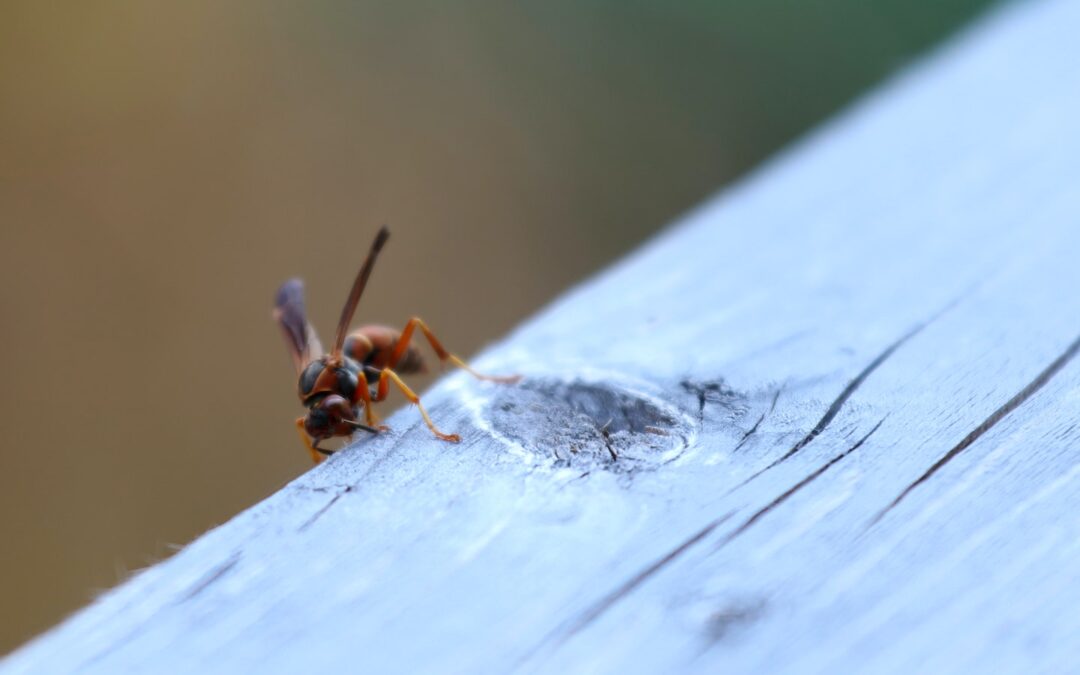Blue mud dauber wasps are solitary wasps in the family Chalybionidae, commonly found in North America. These wasps build nests of mud by gathering and shaping mud into specially made cells. In the wild, they are often found near or around bodies of freshwater, such as lakes and rivers. Blue mud daubers are solitary wasps, meaning they do not live in colonies with other wasps, and they build their nests independently.
Identification
Physical Characteristics
Blue mud dauber wasps range in size from ⅝ inches to 1 inch in length and feature a dark-blue coloring and yellow dots on their abdomens. Their wings are evenly spaced apart, and they have long thin legs that are used to gather mud. Due to their distinct physical characteristics, they can easily be identified among other, more damaging species of wasps, such as yellow jackets and paper wasps.
Sounds
Blue mud daubers are generally quiet and do not make a buzzing noise like other species of wasps. When disturbed, they become very active, although they do not emit the characteristic buzzing sounds that other more aggressive wasps make.
Behavior
Hunting & Eating Habits
Blue mud daubers hunt spiders and collect mud to construct their nests. To hunt and capture their prey, the wasps will land on the walls or other surfaces around the spiders. They then insert their stinger, paralyzing their prey and creating a cocoon of silk and mud as a food source for the wasp’s larva. The wasps will then fly off to the nest to deposit their prey.
Nesting Habits
Blue mud dauber wasps primarily build their nests from mud collected from riverbanks and the shores of bodies of water. The mud is the main component of their nests. The wasps will then seal the nests with more mud, creating small “muddy tombs” with rounded roofs. Inside, they will deposit their prey and an egg, which, when hatched, will feed off of the stored spider provided by the wasp.
Relation to Humans
Friend or Foe?
Blue mud daubers are generally regarded as beneficial insects, as they help rid the environment of spiders which can be considered a nuisance to humans. Their nests are also known for being a form of natural pest control, as the wasps will help keep insect populations in check.
Pest Control
Blue mud dauber wasps can be used as a form of pest control in areas where spiders or other pests may be present in large numbers. It is important to note, however, that these wasps are not considered to be very aggressive towards humans and rarely sting people. If a nest is noticed in a home or building, the best way to remove it is to wait for the wasps to leave and then carefully remove the nest with a broom and dustpan.
People Also Ask
Where are Blue Mud Daubers found?
Blue mud daubers are mainly found in North America, though they have also been sighted in other regions of the world. They are commonly found near lakes, rivers, and other water sources.
What do Blue Mud Daubers eat?
Blue mud daubers primarily eat spiders, which they hunt and return to their nest to feed to their offspring.
What is the lifespan of a Blue Mud Dauber?
The average lifespan of a blue mud dauber is about one year. During that year, the wasp will hunt and build several nests for its offspring before eventually dying.
Are Blue Mud Daubers dangerous?
Blue mud daubers are not usually considered to be dangerous to humans and rarely sting people. If a nest is present in a home, it is generally best to wait until the wasps have left before attempting to remove it.
Do Blue Mud Daubers live in colonies?
No, blue mud daubers are solitary and do not live in colonies. Each individual wasp will build its own nest and care for its own brood of young.
Final Words
Blue mud daubers are solitary wasps that are found mainly in North America. They often build their nests near bodies of freshwater, such as lakes and rivers. These wasps are considered to be beneficial to humans as they help keep insect populations in check. They are not aggressive towards humans and rarely sting people. It is generally best to wait for them to leave before attempting to remove a nest from a home or building.

